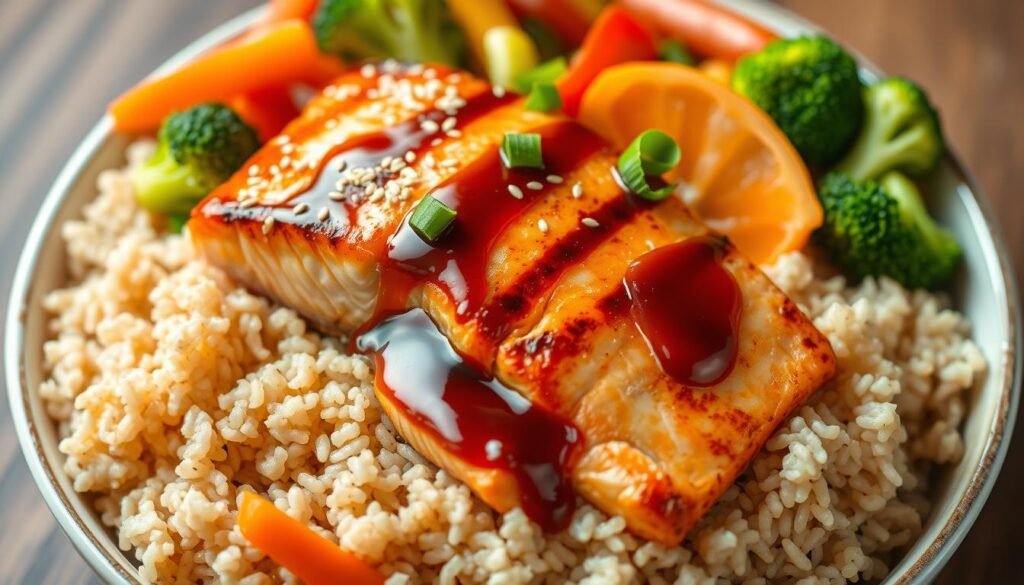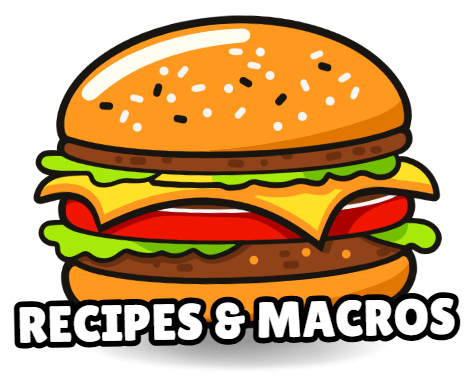For those looking for a delicious yet nutritious meal, the Low-Calorie Teriyaki Salmon Bowl is a standout option. This healthy salmon bowl recipe combines succulent teriyaki salmon with fresh vegetables, all while keeping caloric intake low. Perfect for anyone aiming to balance flavor and health, this dish is rich in protein and packed with essential vitamins and minerals. Enjoy a satisfying meal that fits effortlessly into your low-calorie meals plan.
What is a Teriyaki Salmon Bowl?
A Teriyaki Salmon Bowl is a beloved dish commonly found in Asian cuisine, known for its vibrant flavors and nutritious ingredients. The teriyaki salmon bowl definition emphasizes marinated salmon that is either grilled or baked, enhancing its natural taste. This delicious meal typically features a base of fluffy rice topped with an array of fresh vegetables, creating a well-balanced and satisfying dish.
Traditionally, the term “teriyaki” refers to a cooking method that combines soy sauce, mirin, and sugar to create a sweet and savory glaze. When preparing salmon bowl recipes, the marinating process infuses the fish with delightful flavor, making each bite a treat. Garnishes such as sesame seeds or green onions can elevate the presentation and taste, making the teriyaki salmon bowl a feast for both the eyes and palate.
Benefits of Low-Calorie Meals
Embracing low-calorie meals offers numerous advantages for anyone aiming to improve their health and well-being. A diet rich in low-calorie options can aid in weight management and significantly reduce the risk of chronic diseases. In particular, incorporating salmon into your meals emphasizes its delectable flavors while reaping extensive health benefits.
Health Benefits of Salmon
Salmon stands out as an exceptional choice, celebrated for its abundant omega-3 fatty acids. These nutrients play a crucial role in promoting heart health and reducing inflammation throughout the body. The salmon health benefits extend to brain functionality as well, enhancing cognitive abilities and supporting mental clarity. This fish is not only delicious but also a vital addition to a low-calorie meal plan.
Importance of Low-Calorie Diets
Following a low-calorie diet can positively impact overall metabolic health. Such diets help in controlling blood sugar levels while simultaneously providing a balanced intake of essential nutrients. The advantages of low-calorie diets include enhancing energy levels and improving the body’s ability to burn fat. Integrating a variety of low-calorie meals, such as the Teriyaki Salmon Bowl, serves as a delightful way to maintain a healthy lifestyle.
Ingredients for Low-Calorie Teriyaki Salmon Bowl
Creating a Low-Calorie Teriyaki Salmon Bowl begins with selecting the right ingredients. Each component plays a vital role in delivering flavor while promoting health. This dish pairs perfectly with fresh salmon and a variety of colorful vegetables.
Fresh Salmon
The star of this bowl is undoubtedly the fresh salmon fillet. Typically, a portion of 4-6 ounces delivers a satisfying punch of protein alongside essential omega-3 fatty acids, known for their numerous health benefits. Opting for sustainable sources, such as wild-caught Alaskan salmon, enhances both your meal’s taste and environmental impact.
Low-Calorie Teriyaki Sauce
Crafting a delicious low-calorie teriyaki sauce is crucial for achieving that signature sweet and savory flavor. Use a blend of soy sauce, minced ginger, garlic, and a low-calorie sweetener like stevia or honey. This combination keeps the calorie count low while ensuring every bite bursts with flavor.
Vegetables and Rice Options
Choosing the right vegetables for your salmon bowl adds nutrition and color. Consider options like broccoli, bell peppers, and snap peas for their crisp texture and vibrant hues. As for the base, brown rice, cauliflower rice, or quinoa are excellent choices that boost fiber content without piling on calories.

Step-by-Step Recipe Instructions
Creating a delicious low-calorie teriyaki salmon bowl involves several simple steps. Follow these teriyaki salmon cooking steps to ensure a satisfying meal. With a focus on how to make a salmon bowl, you’ll find this process enjoyable and straightforward.
Preparation of Ingredients
Start by preparing all your ingredients for efficient cooking:
- Wash and chop your choice of fresh vegetables.
- Marinate the salmon in low-calorie teriyaki sauce for at least 30 minutes to enhance the flavor.
Cooking the Salmon
For the next part of the salmon bowl recipe instructions, cooking the salmon is key:
- Preheat your grill or oven to 400°F.
- Place the marinated salmon on a grill or baking sheet.
- Cook the salmon for 12-15 minutes, checking to ensure it flakes easily with a fork.
Assembling the Bowl
Now it’s time for the final touches:
- Take a serving of cooked rice or cauliflower rice and place it at the bottom of your bowl.
- Layer the cooked salmon on top of the rice.
- Add your sautéed or steamed vegetables.
- Drizzle with extra teriyaki sauce and garnish as desired.
By following these easy steps, preparing a tasty salmon bowl becomes an enjoyable experience.
Tips for Perfectly Cooked Salmon
Mastering how to cook salmon involves understanding how to choose the best fish and employing effective cooking techniques. With a few key insights, anyone can achieve delicious results.
Choosing the Right Salmon
When choosing salmon for teriyaki, opt for vibrant colors and a slight sheen, indicating freshness. Firmness is crucial; fresh salmon should feel solid to the touch. Wild-caught salmon typically surpasses farmed varieties in flavor and omega-3 content, enhancing the overall dish. Look for options such as Sockeye or King salmon, known for their rich taste and texture.
Cooking Techniques
For those wondering how to cook salmon, several methods yield excellent results. A few cooking salmon tips include:
- Grilling: This method imparts a wonderful smoky flavor while keeping the fish moist.
- Baking: Ideal for even cooking, baking at a moderate temperature can create tender salmon.
- Broiling: Provides quick, high heat that crisps the outside while locking in juices.
Each method can elevate the taste while preventing overcooking. Aim for an internal temperature of 145°F to ensure the salmon remains juicy and flavorful.
Macronutrient Breakdown of the Dish
Understanding the macronutrient breakdown of your meals plays a crucial role in maintaining a healthy diet. The caloric breakdown of the salmon bowl showcases its nutritional benefits, especially for those seeking high-protein low-calorie meals.
Caloric Content
A typical serving of the Low-Calorie Teriyaki Salmon Bowl offers a satisfying caloric range of around 400–500 calories. This variation largely depends on the amount of rice and vegetables included. With such a calorie count, this dish becomes an appealing choice for those conscious of their caloric intake.
Protein, Fat, and Carbohydrate Ratios
The macronutrient composition of this dish includes approximately 30 grams of protein, 15 grams of fat, and 35 grams of carbohydrates. These numbers illustrate how this recipe supports a low-calorie diet while ensuring that protein levels remain high enough to promote satiety.
| Macronutrient | Amount (grams) |
|---|---|
| Protein | 30 |
| Fat | 15 |
| Carbohydrates | 35 |
| Total Calories | 400–500 |

Alternatives to Increase Flavor
To elevate the taste of your Teriyaki Salmon Bowl, exploring various spice alternatives and ingredient substitutions can introduce exciting new dimensions. A little creativity in the kitchen often leads to delightful surprises!
Spice Variations
For those who enjoy a bit of heat, crushed red pepper flakes make an excellent addition when flavoring teriyaki bowls. Fresh herbs, such as cilantro or basil, can infuse your dish with freshness and aroma. Consider some of these spice alternatives to further customize your bowl:
- Ginger powder for a warm, zesty kick
- Garlic powder to enhance overall depth
- Cumin for a subtle earthiness
- Sesame seeds for additional crunch and flavor
Substituting Ingredients
Ingredient substitutions in salmon bowls can help accommodate dietary preferences while still keeping the flavor intact. If you want to cut down on sodium, opting for low-sodium soy sauce is a wise choice. Making your own teriyaki sauce allows you to adjust the salt levels according to your needs. Furthermore, consider these alternatives:
- Swap regular rice for zucchini noodles for a low-carb option
- Try cauliflower rice as a nutritious substitute
- Mix in different vegetables like bell peppers, snow peas, or carrots for added color and texture
| Ingredient | Traditional Option | Substitution |
|---|---|---|
| Rice | White Rice | Zucchini Noodles |
| Sauce | Regular Soy Sauce | Low-Sodium Soy Sauce |
| Toppings | Chopped Green Onions | Fresh Cilantro or Basil |
Serving Suggestions for Your Bowl
When it comes to serving salmon bowls, the experience can be elevated with thoughtful pairings and presentation. Consider what complements the flavors of your low-calorie teriyaki salmon bowl to enhance the overall meal.
Best Pairings
- Fresh cucumber salad adds a crunchy texture.
- Miso soup provides warmth and depth, balancing the lightness of the bowl.
- Edamame introduces protein and fiber, making the meal more satiating.
These pairing suggestions for teriyaki dishes not only enrich the flavors but also contribute to a more nutritious dining experience.
Presentation Ideas
How to present a salmon bowl matters just as much as the taste. Consider layering the ingredients for a visually appealing display. Use a vibrant array of colors by integrating a mix of vegetables alongside the salmon. Garnishing with:
- Sesame seeds for a nutty crunch.
- Chopped green onions for a pop of color.
- A lemon wedge for brightness and acidity.
These simple tips enhance visual appeal, making your dish not only delicious but also stunning to look at.
Storage and Leftover Tips
When it comes to how to store leftover salmon from your Low-Calorie Teriyaki Salmon Bowl, the key is to keep it fresh and flavorful. Place any uneaten portions in an airtight container and store them in the refrigerator, where they can last for up to three days. For optimal taste, make sure to keep the salmon separate from the rice and vegetables until you’re ready to enjoy it again.
For reheating, you have a couple of options. You can use a microwave or an oven, but be cautious not to overcook the salmon. The goal is to ensure the salmon is heated through while retaining its moisture and flavor. These leftover teriyaki bowl tips will help you to enjoy your meal prep salmon bowls with the same delicious taste as when they were freshly made.
If you’re looking to get the most out of your meal prep, consider portioning the ingredients before storing them. This makes it easier to reheat just what you need, ensuring that every bite of your teriyaki bowl remains enjoyable. Whether for a quick lunch or dinner, these storage tips will keep your salmon and other ingredients in prime condition for delicious meals throughout the week.

